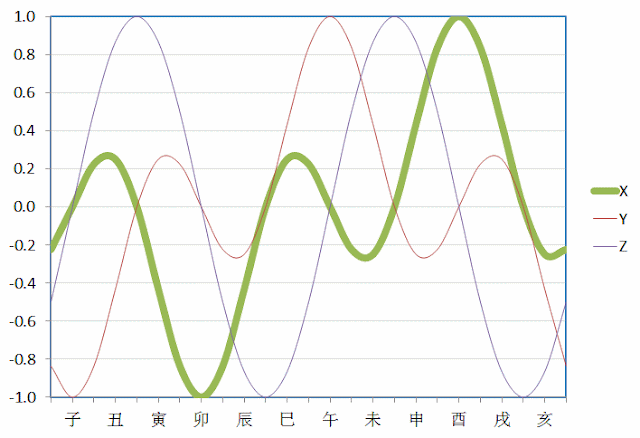The Standard Model
Starting from the Standard Model -- the version that yields zero magnitudes in the Z axis for 3-Fusion and 3-Union patterns:It is now possible to compile the equation governing the Zhi cycle's trajectory in the Five Elements Phase Space. The transition from 丑 to 寅, for instance, flips the vector to the opposite side of the plane; same thing for 辰 to 巳, 未 to 申, 戌 to 亥.
This behavior can be successfully modeled by a vector that not only rotates through 360° in the X-Y plane, but also rotates into the Z dimension.
Vector Illustration
Consider a vector that rotates in the X-Y plane through the angle θ, while at the same time rotating by an angle φ about an axis in the X-Y plane that is perpendicular to the vector's projection into X-Y:When φ > 90°, the vector flips to the opposite side of the X-Y plane, creating the behavior that we observe in the Zhi cycle.
Mapping the vector rotation with components of the Zhi cycle items, it is easy to come up with the fact that:
φ = 2θIn other words, as the vector rotates 360° through the X-Y plane (representing one complete period of the Zhi cycle), the vector rotates into the Z dimension through 720° -- or two complete rotations.
The Standard Model Formula
Assuming a unit vector:`x = cos phi sin theta = cos 2 theta sin theta`The minus sign for y is simply there to cast water into negative and fire into positive, instead of the other less-intuitive way.
`y = -cos phi cos theta = -cos 2 theta cos theta`
`z = sin phi = sin 2 theta`
There is a minor adjustment required. In classical literature, the zhi items 子, 卯, 午, 酉 point to compass directions only in the middle of their segment. For example, when the Zhi cycle is applied to mark time, the hour represented by 子 is 11:00pm on the previous night to 1:00am, with the mid-point being midnight. Essentially, only at midnight is the vector for 子 coinciding with the Y axis.
Since each Zhi item occupies 30° in a complete circle, the Zhi cycle must therefore start with θ = -15° instead of θ = 0°.
Formula Behavior
The Zhi cycle when projected on the X-axis takes on the following values (as shown with the green line):Negative is wood while positive is metal. The 3-Fusion for wood (寅, 卯, 辰) and 3-Fusion for metal (申, 酉, 戌) are both clearly seen as the lowest trough and highest peak respectively. The lowest/higher points, together with the two sub-depression/sub-peaks surrounding them, form the 3-Union patterns for wood and metal respectively.
Projections on the Y axis (red line) shows similar behavior:
Projections on the Z axis (blue line) is a simple sine curve:
It can be seen immediately that, for all Zhi items with earth as component (i.e. all the items that do not point to pure compass directions) have component values at the mid-point of 0.87 -- almost 90% of the peak value.
This explains why, in classical literature, the earth components of these Zhi items cannot be ignored -- they are almost stronger than any other component -- while there are no earth components for the four Zhi items pointing to pure compass directions. For those items, the actual earth component takes on various values from positive to negative, while that component is zero at the mid-point.
Quaternion Interpretations
The rule φ = 2θ is interesting because, as θ goes from 0° to 360°, φ goes from 0° to 720° (or two complete revolutions). It is well known in geometry and topology that a rotation by360° in three dimensional space is not a symmetry operation (i.e. an object remains twisted), but 720° is symmetric (i.e. the object rotated is not twisted) -- a fact described by the mathematics of quaternions and spinors.The Standard Model formula describes a curve on the three-dimensional quaternion hypersphere -- a "figure-eight" curve with two loops on both the northern and southern hemisphere. When the hypersphere (in blue) is looked upon from the top, the curve (in red) looks like:
The plane shows θ going from 0° to 360°, while the third dimension (through the plane) ranges from a rotation φ from 0° to 360° -- 0° is the north pole and 360° is the south pole. The red circle is actually two circles stacked on top of each other -- one in the northern hemisphere and one in the southern hemisphere. The trajectory follows a figure-eight path tracing through these two circles.
In the previous entry, it is mentioned that another possible mapping of the Z-axis:
It has fewer redeeming qualities than the Standard Model -- for example, the 3-Fusion and 3-Union patterns yield non-zero components in the Z-axis. It is also less uniform to fit resulting vector trajectory.
However, this mapping can be described by a great circle on the quaternion hypersphere. But unless the great circle follows the longitudes and go through both poles, the four compass directions 子, 午, 卯, 酉 must also have non-zero components in the Z-axis.
No ancient Chinese texts associated any earth component for 3-Fusion, 3-Union and the four compass directions, except for 午 -- but this fact is explained in a future entry.







No comments :
Post a Comment